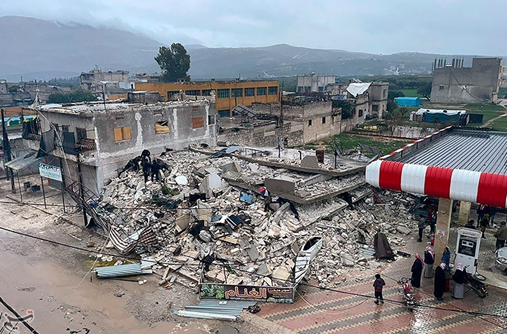By the time I finished writing this post, over 43,000 has been found dead in the devastating event that struck Türkiye and Syria, and hundreds of thousands were left homeless. In Türkiye alone, over 5600 buildings collapsed.
What Happened?
On 6 Feb 2023, a series of earthquake occurred in southeast of Türkiye. The recorded epicenter is close to Gaziantep, with its hipocenter at 10miles (16km) from the surface. The first earthquake with magnitude 7.8 happened at 4:17am local time. A series of aftershocks with magnitude 6.5 followed until another large earthquake with magnitude 7.5 occurred at around lunchtime. The area is known to be seismically active, as it is located at the intersection of three tectonic plates

Reading the brief explanation from Dr. Subramanian Narayanan, during the earthquake, the peak ground acceleration (PGA) of the first mainshock reached to around 0.7g, with the spectral acceleration exceeded 2g around 0.5-0.6 seconds (See Figure). To put it into perspective, any buildings with vibration period of 0.5s to 0.6s would experience maximum lateral force as much as two times its own weight! Followed with a series of high magnitude earthquakes, it resulted in total collapse of many old buildings, as well as some new buildings! If you are interested in knowing more, you can read here. It is the deadliest earthquake in the last 100 years.
The Damage
From the internet, I found various footages showing the damage from the earthquake to the existing structures around. To my surprise, numerous buildings were completely flattened, such as the building in Izmir, shown below.

https://www.theguardian.com/world/gallery/2020/oct/30/aegean-earthquake-turkey-greek-islands-in-pictures

https://en.wikipedia.org/wiki/2023_Turkey%E2%80%93Syria_earthquake
And this footage:
It caught my attention seeing how some of the buildings collapsed in the video above (another one here). During the earthquake, some buildings showed sudden failure at Ground Level with no visible major failure at the upper floors (see image below), and the next thing we know, the building completely collapsed in a short time, bottom-up. This type of failure is detrimental because it happens suddenly (brittle failure) and leaving no time for the occupants or the people around to escape.

As a structural engineer, damage at this scale has brought many questions to me, such as what caused such damage, what went wrong, and most importantly, how can we do better? Earthquakes don’t kill people, buildings do. It is a commonly known phrase that cannot be truer in this tragedy.
Maybe the Earthquake is Simply Too Big?
Earthquake-resistant structural design is based on the seismic hazard of the region, which is derived from earthquakes recorded in the past (and a lot of statistical post-processing). Therefore, it is impossible to know if we have designed our building against the largest earthquake possible. However, this is not the end of the story, as designing building is much more than just making it ‘strong enough’!
Quoting from Eurocode 8, the main purpose of earthquake-resistant building design is: (1) Human lives are protected, (2) Damage is limited, and (3) Structures important for civil protection remain operational. These are achieved through the design and detailing criteria set out in the code, resulted in types of failure which are ductile and thus avoid any sudden collapse, allowing the people to escape. The focus is not only designing a building that can resist the loading required, but also to control its damage or failure in extraordinary cases.
A well-known example is the design of a car’s bonnet or hood. In a car crash, this part is designed to get crushed (crumple zone) and absorb the energy, minimising the impact to the occupant, which is protected within the safety cage.

In building, for instance, one design method is called “strong column, weak beam” which means the design of the column should be stronger than the beam, such that the beam will absorb any damage before the column. The beam would become the sacrificial part in the form of plastic hinges, which is ductile and would prevent instant failure to the whole structure. There are other methods such as using shear wall, braces, and bearings, where these elements are designed to absorb the damage before anything else.

My Takeaway
As a structural engineer, we are very good at designing our structures to be stiff and strong enough to resist any loading required by the design standards. However, have we taken a second look into our design? If something beyond our design happens, how would it behave? Will it be a sudden failure, or will it be able to absorb the damage to some degree, before it finally breaks, giving people the chance to escape?
Designing building structures is much more than just the physics and the materials. It requires us to also think about how we provide the space where people know they are safe and secure, even at unexpected times. This is easier said than done, but having the knowledge and ability to do so, I believe it is a responsibility we must take, to avoid such tragedy to repeat itself.
Extras
Just for your information, some videos not related to the event are going around misleading people (https://www.thequint.com/news/webqoof/old-videos-shared-as-recent-turkey-earthquake-fact-check#read-more).
And, if you are interested in keeping up-to-date with the earthquake events going around the globe, check Force Thirteen: Earthquake’s YouTube channel (link). They do 24/7 live streaming, broadcasting any recorded earthquake. Below is the screenshot of the broadcast during the second earthquake in Turkiye.

